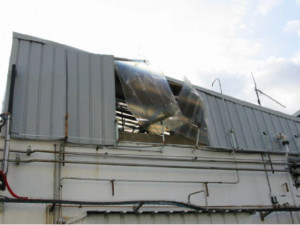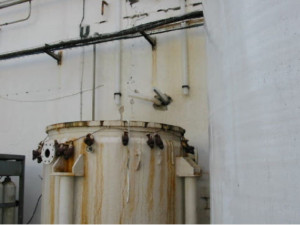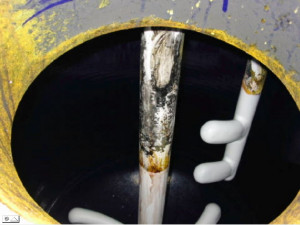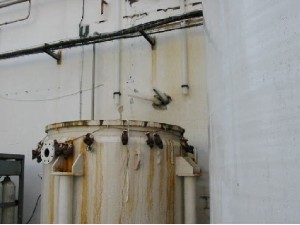In a fine chemistry plant employing 70 staff, a 1,500-litre enamelled reactor underwent a pressure surge and exploded during the oxidation of 200 kg of dichloro-dicyano-hydroquinone (DDHQ) into dichloro-dicyano-quinone (DDQ) by means of nitric acid and oxygen in a solvent medium (dichloromethane). This reaction had been carried out onsite for many years without any recorded incident. The explosion, audible over a several-km radius, occurred during the second introduction of oxygen into the reactor during the oxidation phase. Fire-fighters and gendarme officers quickly arrived at the scene. Two employees were hospitalised: one, shocked by the explosion, returned to his post 2 hours later; the other, who sustained slight burns, an eye irritation and mild eardrum trauma, was discharged only after spending the night for observation. Rupture of the reactor’s safety disc served to limit the explosion effects to a perimeter of just a few metres around the reactor: roofing and siding on the production building were deformed, and the plastic (PVDF) pipes and flanges downstream of the disc were dislodged. According to the press, nearly a kg of debris (a fitting with 4 bolts) was found on a neighbour’s property 70 m from the explosion site. The batch being manufactured was destroyed; production was shut down and the installation placed in safe operating mode while awaiting conclusions of the technical investigation to determine the exact origin and circumstances of the explosion. It was discovered that the deflagration only involved the gaseous phase of the reaction medium but did not formally identify the phenomenon triggering the explosion. The most likely hypothesis was the self-detonation, occurring in a recess of the reactor created by the pipe layout, of the dichloromethane / hydrogen mix (resulting from acid corrosion of an unprotected metal surface) with an enriched oxygen content due to multiple degassing operations. A point of corrosion was observed on top of the stirring axis. This defect on the enamelled lining had been caused by a shock when repositioning the stirrer following an inspection. Moreover, while both the disc and rupture valve performed their respective functions, they had not been designed for such a deflagration, nor had the transfer pipes leading to the crash tank.
Download the detailed report in .pdf format (177 Kb)







